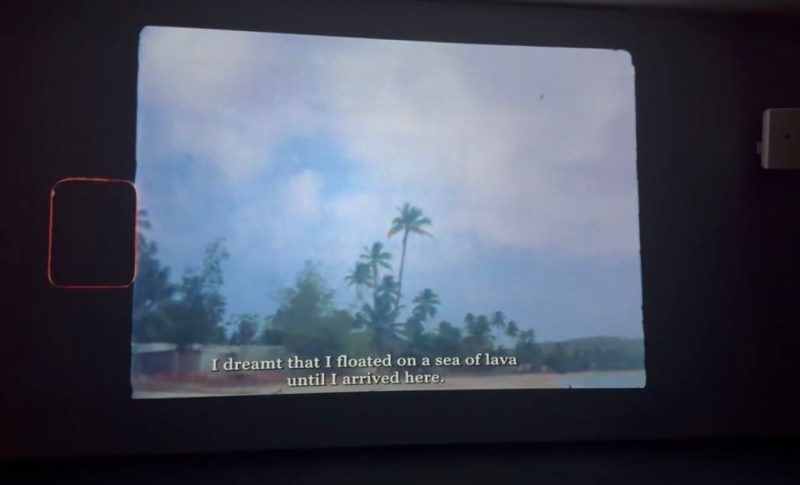In “Cardinal Canvas,” Adam Golomb spotlights art on and around the University, exploring and reviewing artwork that students may otherwise miss.
Editor’s Note: This article is a review and contains subjective opinions, thoughts and critiques.
“This is a film about impermanence,” Sofía Gallisá Muriente declares halfway into her forty-one minute video artwork “Celaje (Cloudscape).”
Throughout the film, Muriente invites her audience to an elegy for her homeland of Puerto Rico and the devastation caused by Hurricane Maria in 2017, which killed nearly 3,000 Puerto Ricans.
In somber reflection of Puerto Rico’s once-held beauty contrasted with its current state, the piece questions how one learns to grieve their home and reclaim their cultural legacy.
“Inevitably, the day comes, be it decades, centuries or millenniums later, when all that is left of the rock is some grains of sand,” the subtitles read while Muriente’s late grandmother speaks in Spanish. On the screen: black and white waves crashing, enacting the slow process of erosion alongside the cliffside.
Muriente ruminates on nature’s relentless course; the footage, purposely distorted and degraded, representing the ravaging of her land. The scene is mesmerizing in its scale as every tiny rock along the beach is swallowed by the vast ocean.
“Testing, testing, uno, dos, tres, uno, dos, tres,” a male voice recites while old home videos play. Lowly saturated scenes of women cooking and laughing at a barbecue paint a picture of the happiness and beauty of Puerto Rico. A little boy runs around with the flag, giddy.
Muriente gives the audience a peek into the wonders of her heritage so we can understand what we’re mourning. Watching this, I smiled to myself at the pride Muriente clearly has for her home, but behind that smile was an anxiety, an anticipation of catastrophe.
“Something is happening, the lightbulb is failing,” the same man suddenly says, with urgency and fear. The music, previously simple background noise behind the old footage, starts overlapping on itself and escalates into a loud crescendo.
Then, a cut to black. Silence. Emerging from this, a scene of a funeral as a coffin with the Puerto Rican flag is lowered into the ground, a family inaudibly saying their goodbyes.
“Celaje” depicts the deep sadness of losing one’s love, one’s home. The sense of unpreparedness Muriente crafts is overwhelming, and gives the piece’s audience the experience of watching one’s site of life implode rather than gradually fade away. I can’t help but question which is worse: an abrupt departure or creeping disintegration. Muriente herself doesn’t decide, but masterfully presents the reality of the first. I ache with her.
“Without debt, there is no paradise,” the subtitles read on scenes of abandoned buildings pre-hurricane. Muriente then dives into Puerto Rico’s history as a colony, drawing parallels between its violent past and the present harm caused by Hurricane Maria. “Celaje” depicts the literal looming presence of imperialism in Puerto Rico throughout the film, panning up to a “General Motors,” “Ford” or “Sinclair” logo during scenes of everyday life.
Muriente compares history to natural disasters; both have consumed buildings and lives, the material evidence of her culture. She depicts colonialism and the hurricane alike as destroyers of heritage and creators of ruins.
“The blank film I had been keeping in my freezer started rotting when the hurricane took the power out,” Murriente discloses. The screen shows the jungle during the darkest of nights, impossible to navigate. “Celaje” brings the audience into a similarly frightening unknown of disaster – the death of one’s home.
In her potent examination of devastation and mourning, Muriente explores a land of collapse and the dissolution of history. The film poses the following question: What does one do when the tools of documentation literally rot?
Again, Muriente allows her audience to decide for itself, but I view “Celaje” as her way of rectifying these casualties of memory. I see “Celaje” as a declaration of history and heritage. Muriente’s answer to the above question: Start documenting again, with love and care.
Muriente’s “Celaje” is simply beautiful. Disorienting at times, deeply moving and compellingly thought-provoking, I implore everyone to run to the Cantor to see this piece before May 19.
